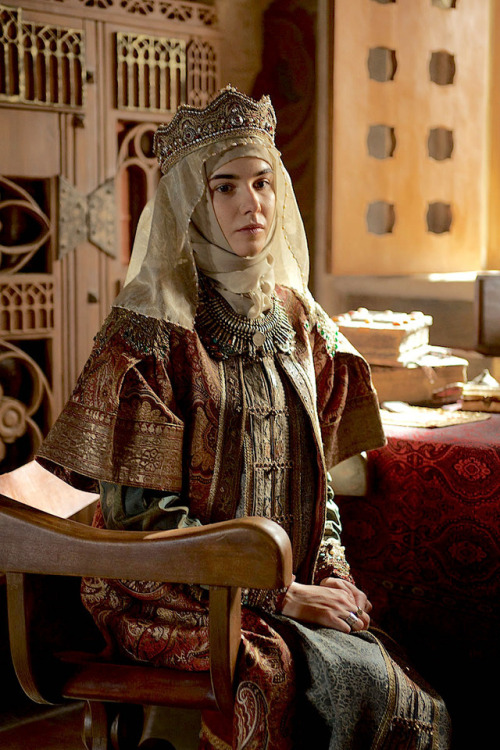 |
| Maria Andreeva as Sophia Palaiologina in the Russian TV series "Sophia" (2016) |
The Grand Duchess of Moscow
Zoe (Sophia) Palaiologina, Grand Duchess of Moscow, was a niece of the last
Byzantine Emperor Constantine XI and second wife of Ivan III of Moscow.
The fall of Constantinople in 1453 was not the total collapse of the Eastern Roman Empire. In southern Greece the Byzantine Despotate of the Morea continued on until 1460.
The title despotes should not be confused with the term of despotism. A Despot was a senior Byzantine court title. From the mid-fourteenth century on the title was given to Imperial princes to act as the local ruler of semi-autonomous provinces of the Empire.
So in 1453 we see the surviving members of the Palaiologos dynasty (Demetrios and Thomas) ruling over the Despotate of Morea. These were two brothers of the last Emperor Constantine XI.
 |
| Thomas Palaiologos Despot of Morea |
The brothers not only failed to send any troops to defend Constantinople, but their incompetence sparked a massive revolt by 30,000 Albanians and Greeks against their rule.
The situation was so bad the brothers invited the Muslim Turks in to kill their own people in order to retain power.
Morea became a vassalage of the Ottoman Empire. After falling behind in tribute, Sultan Mehmed II invaded in May, 1460. The Turks quickly breached the Hexamilion wall and put an end to this last shred of the Roman Empire.
Demetrios became a prisoner of the Ottomans. Thomas, his wife Catherine and children Zoe (Sophia), Andreas, Manuel and Helena a fled to Corfu and then Thomas went to Rome.
Thomas was already recognized as the legitimate heir to the throne by the Pope. Leaving his children behind in Corfu, in 1461 Thomas made a ceremonial entrance into Rome and the Byzantine Emperor.
Zoe and her brothers remained in Corfu until recalled to Rome by their dying father in 1465.
 |
| The Despotate of Morea in southern Greece was the last holdout against the Turks when Constantinople fell in 1453. |
Zoe (Sophia) Palaiologina
As the granddaughter of Emperor Manuel II Palaiologos, Zoe now became something of a political pawn of the Pope and the Catholic Church.
Zoe was born in 1440 or 49. So she could have been as young as 16 years old in 1465 when she came to Rome to see her father.
Upon her father's death Zoe and her brothers were adopted by the Pope Paul II. Her Greek name was changed to Sophia. Born to the Orthodox Church it is possible she was raised as a Catholic while living at the Court in Rome.
Care of the Imperial children was assigned to Cardinal Basilios Bessarion, the Latin Patriarch of Constantinople. Letters show the Pope closely followed the care and education of the children.
 |
| Using the Byzantine eagle. Reverse of Ivan III's seal from 1472, after his marriage with Sophia Paleologue |
In 1466 the Venetian Republic invited King James II of Cyprus but he refused. Around 1467 Pope Paul II offered Sophia's hand to a Price Caracciolo. They were betrothed but the marriage never took place.
In 1467 the wife died of Grand Prince Ivan III of Moscow. Pope Paul II viewed this as yet another opportunity to abolish the Orthodox Church and expand the influence of Rome.
Pope Paul proposed the marriage with Sophia in 1469. The Pope wanted to expand his power, but Ivan was no doubt looking at connecting to the status and rights of Byzantine royalty. The marriage negotiations went on for three years.
A marriage by proxy was held in Rome on June 1st, 1472. Queen Catherine of Bosnia was one of many who attended. As a dowry Sophia brought 6,000 ducats. There is no record where that money came from. Possibly from the Pope.
The entourage with Cardinal Bessarion, traveled north through Italy to Germany where she took a ship to Russia. She landed in Tallinn (in modern Estonia). At Pskov she was officially celebrated. It was noted that Sophia personally thanked the public for the celebration. On November 12, 1472 Sophia arrived in Moscow.
 |
| Ivan III Grand Prince of Moscow |
The Pope's plans fail. Once Sophia reached the safety of Russia she abandoned the Catholic Church and returned to her Orthodox faith. The Papal Legate carrying the Latin cross was not even allowed into Moscow.
The formal wedding between Ivan and Sophia took place on November 12.
Ivan had special palaces and gardens built for Sophia. It appears Sophia was not required to be isolated with other women as was common in Russia at the time. She even greeted representatives from Europe as Queens in western Europe did.
In 1472 Sophia was effected by the formal tributary gesture Ivan made to Mongolian representatives. It is believed she urged Ivan to break with the Mongols in 1480.
Russian nights being very cold saw Grand Princess Sophia give birth to eleven children, five sons and six daughters. Among her children was the future Grand Prince of Moscow Vasili III.
With Sophia at his side Ivan developed a complicated court ceremony patterned on the Byzantine model. Ivan also began using the title "Tsar and Autocrat." Both Ivan and his son Vasili started to use the term "Third Rome" when speaking of the Russian nation.
Sophia passed away April 7, 1503 and was buried in massive stone sarcophagus in the Ascension Convent in the Kremlin. Ivan passed two years later.
 |
| Ivan III. Note the Byzantine eagle on the shield. With his marriage to Sophia Ivan began using the title Tsar and calling Moscow the Third Rome. |
 |
| Ivan III and Sophia Palaiologina at court. |
 |
| Destruction of Sophia Palaiologina's grave by the Communists in 1929. |
(Thomas Palaiologos) (Ivan III) (Sophia Palaiologina) (Ascension Convent)